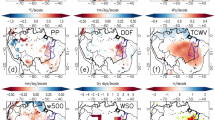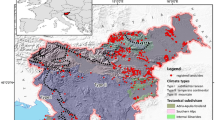Abstract
Steep-slope agricultural systems are important for food production worldwide. Here we provide a high-resolution global map of steep-slope agricultural landscapes and their spatial distribution in the Köppen–Geiger climate zones for the present day (1980–2016) and future (2071–2100) scenarios. Our analysis demonstrates that steep-slope agricultural areas are much more affected by shifting climate zones than average global agricultural lands, especially by the expansion of arid zones.
This is a preview of subscription content, access via your institution
Access options
Access Nature and 54 other Nature Portfolio journals
Get Nature+, our best-value online-access subscription
$29.99 / 30 days
cancel any time
Subscribe to this journal
Receive 12 digital issues and online access to articles
$119.00 per year
only $9.92 per issue
Buy this article
- Purchase on Springer Link
- Instant access to full article PDF
Prices may be subject to local taxes which are calculated during checkout


Similar content being viewed by others
Data availability
All the data that support this study are available on GitHub at https://github.com/ptarolli/NatFood; the present and future Köppen–Geiger climate classification maps source dataset is available at http://www.gloh2o.org/koppen/. Source data are provided with this paper.
Code availability
The Google Earth Engine code produced in this study is provided in the source data for Fig. 1 and is deposited on GitHub (https://github.com/ptarolli/NatFood) for free use and distribution.
References
Tarolli, P., Pijl, A., Cucchiaro, S. & Wei, W. Slope instabilities in steep cultivation systems: process classification and opportunities from remote sensing. Land Degrad. Dev. 32, 1368–1388 (2021).
Davidson, D. Gaps in agricultural climate adaptation research. Nat. Clim. Change 6, 433–435 (2016).
Pokhrel, Y. et al. Global terrestrial water storage and drought severity under climate change. Nat. Clim. Change 11, 226–233 (2021).
Rosenzweig, C. & Parry, M. Potential impact of climate change on world food supply. Nature 367, 133–138 (1994).
Behringer, J., Buerki, R. & Fuhrer, J. Participatory integrated assessment of adaptation to climate change in Alpine tourism and mountain agriculture. Integr. Assess. 1, 331–338 (2000).
Grüneis, H., Penker, M. & Höferl, K. M. The full spectrum of climate change adaptation: testing an analytical framework in Tyrolean mountain agriculture (Austria). SpringerPlus 5, 1848 (2016).
Kohler, T., Wehrli, A. & Jurek, M. Mountains and Climate Change: A Global Concern (Centre for Development and Environment, Swiss Agency for Development and Cooperation and Geographica Bernensia, 2014).
Hussain, A., Rasul, G., Mahapatra, B. & Tuladhar, S. Household food security in the face of climate change in the Hindu–Kush Himalayan region. Food Secur. 8, 921–937 (2016).
Borrelli, P. et al. Land use and climate change impacts on global soil erosion by water (2015–2070). Proc. Natl. Acad. Sci. USA 117, 21994–22001 (2020).
Tarolli, P., Preti, F. & Romano, N. Terraced landscapes: from an old best practice to a potential hazard for soil degradation due to land abandonment. Anthropocene 6, 10–25 (2014).
Wheeler, T. & von Braun, J. Climate change impacts on global food security. Science 341, 508–513 (2013).
Shaxson, F. New Concepts and Approaches to Land Management in the Tropics with Emphasis on Steeplands (FAO, 1999).
Arnell, N. W., van Vuuren, D. P. & Isaac, M. The implications of climate policy for the impacts of climate change on global water resources. Global Environ. Change 21, 592–603 (2011).
Duku, C., Zwart, S. J. & Hein, L. Impacts of climate change on cropping patterns in a tropical, sub-humid watershed. PLoS ONE 13, e0192642 (2018).
Olesen, J. E. et al. Impacts and adaptation of European crop production systems to climate change. Eur. J. Agron. 34, 96–112 (2011).
Rippke, U. et al. Timescales of transformational climate change adaptation in sub-Saharan African agriculture. Nat. Clim. Change 6, 605–609 (2016).
Beck, H. E. et al. Present and future Köppen–Geiger climate classification maps at 1-km resolution. Sci. Data 5, 180214 (2018).
Riahi, K. et al. RCP 8.5—a scenario of comparatively high greenhouse gas emissions. Clim. Change 109, 33–57 (2011).
Acknowledgements
This study was partly supported by University of Padova research projects ‘ViTE – Vineyard terraced landscapes: understanding the environmental constraints to improve sustainable management’ (DALL_FINAC_P14_02) and ‘Analysis of erosion and water stagnation in the agricultural context’ (DOR2180998/21), and by the project SOiLUTION SYSTEM ‘Innovative solutions for soil erosion risk mitigation and a better management of vineyards in hilly and mountain landscapes’, within Programma di Sviluppo Rurale per il Veneto 2014-2020 (Regione del Veneto).
Author information
Authors and Affiliations
Contributions
P.T. conceived and designed the research. W.W. and A.P. performed the data analysis and produced the figures. P.T. and W.W. wrote the first draft of the manuscript, and all the authors reviewed and edited the manuscript.
Corresponding author
Ethics declarations
Competing interests
The authors declare no competing interests.
Peer review
Peer review information
Nature Food thanks the anonymous reviewers for their contribution to the peer review of this work.
Additional information
Publisher’s note Springer Nature remains neutral with regard to jurisdictional claims in published maps and institutional affiliations.
Supplementary information
Supplementary Information
Supplementary Table - Overview of steep-slope agricultural heritage sites by UNESCO and FAO.
Source data
Source Data Fig. 1
Source code for Fig. 1 to be used in the Google Earth Engine.
Source Data Fig. 1
Source data shape file, related to the 50 steep cultivated landscapes protected and recognized as heritage sites by UNESCO and FAO, to be used in GIS to set up Fig. 1; these data, in addition to the file related to steep-slope agriculture, will be uploaded on GitHub at https://github.com/ptarolli/NatFood.
Source Data Fig. 2
Source of two pie charts summarizing the distribution of global steep-slope agricultural landscapes; for the climate shift raster file please refer to the open source dataset of Beck et al.17.
Source Data Fig. 2
Source data to be used in GIS to set up the small map in Fig. 2, showing where in the world the main climate classes (for example tropical, arid, etc.) have shifted (red zones); these data will be uploaded on GitHub at https://github.com/ptarolli/NatFood. For the GIS data related to present and future Köppen–Geiger climate classification maps the source dataset is available at http://www.gloh2o.org/koppen/.
Rights and permissions
About this article
Cite this article
Wang, W., Pijl, A. & Tarolli, P. Future climate-zone shifts are threatening steep-slope agriculture. Nat Food 3, 193–196 (2022). https://doi.org/10.1038/s43016-021-00454-y
Received:
Accepted:
Published:
Issue Date:
DOI: https://doi.org/10.1038/s43016-021-00454-y
This article is cited by
-
Climate Change Impacts on Agroecosystems in China: Processes, Mechanisms and Prospects
Chinese Geographical Science (2023)
-
Shifting climate zones and expanding tropical and arid climate regions across Kenya (1980–2020)
Regional Environmental Change (2023)



